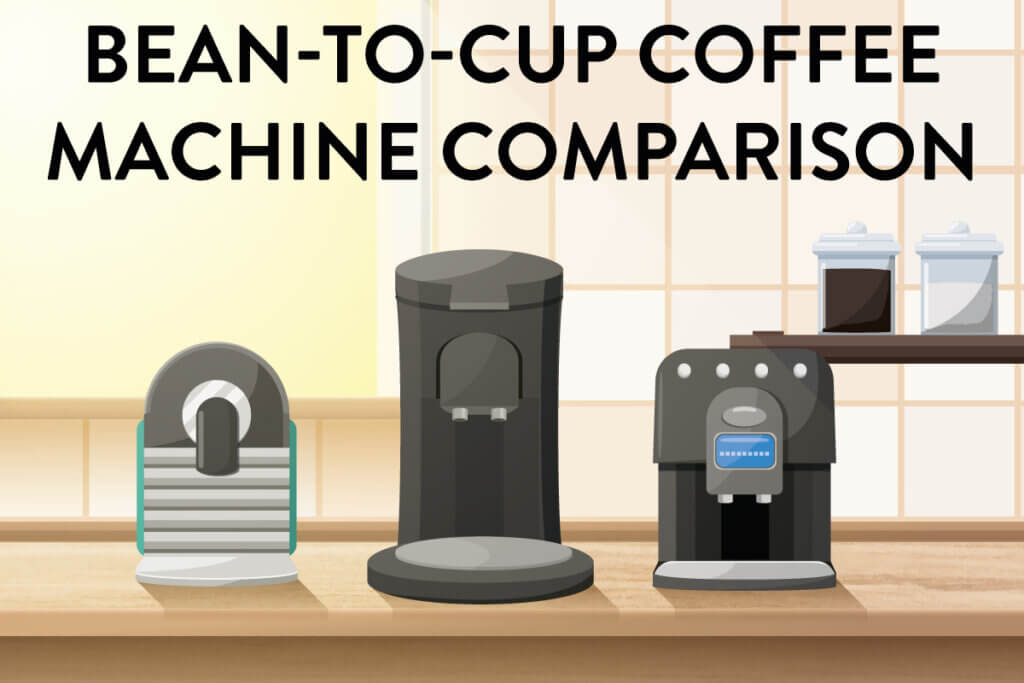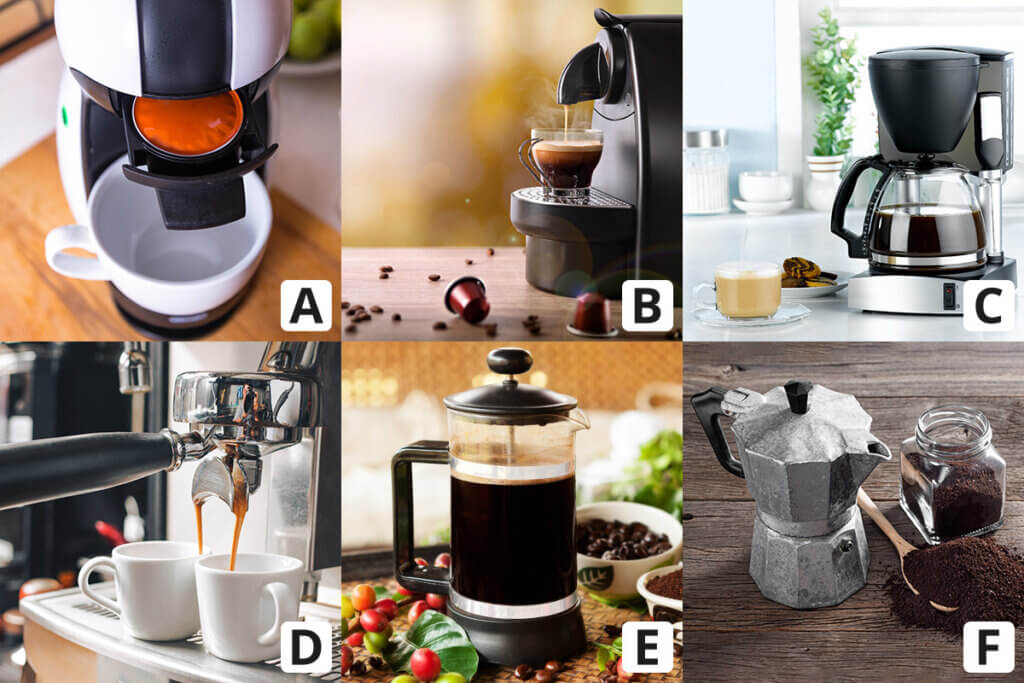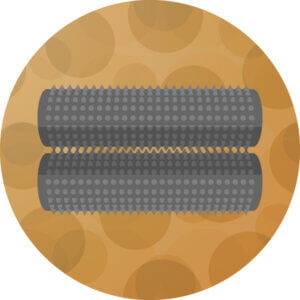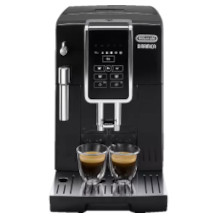Bean-to-cup coffee machine purchasing advice: how to choose the right product
- What you need to know
- Bean-to-cup coffee machines are fully automatic. This means no more messing around with filters, pads, or capsules. These all-rounder devices are eco-friendly, quick, and easy to use.
- Whether you like espresso, filter coffee, or cappuccino, bean-to-cup machines can do it all thanks to their integrated milk frothers.
- Freshly ground beans combined with perfect temperature water means you get some seriously aromatic results with a bean-to-cup machine. A lot of machines will let you adjust grind coarseness and coffee strength to suit your own taste.
- Bean-to-cup models differ in terms of how they froth milk, grind the beans, which type of group they use, and how much capacity they have.
- Additional features like automatic standby and the ability to save settings can make daily use more comfortable.
- You need to properly maintain your machine to ensure it lasts as long as possible and continues to make good coffee.

The best of the best for coffee lovers
Coffee isn’t just a drink; for a lot of us, it’s a passion. Whether as a morning ritual, a midday pick-me-up, or just as a chance to take a breather, coffee is always a great option – in fact, not having at least one steaming cup a day is unthinkable for a lot of us. When it comes to early mornings, the priority is being able to make a cup quickly and easily. However, not all styles of coffee are quick and easy to make. Depending on the method, some cups of coffee can take quite a long time to brew. Thankfully, back in the 1970s coffee machine manufacturers saw this issue and came up with a solution: the fully automatic bean-to-cup coffee machine. While the tech is old, the popularity of these machines is alive and kicking. Today, they’re experiencing somewhat of a renaissance, as people look for ways to make great cups of coffee without much effort.
Bean-to-cup machines are a great option both for your home and the office. Whether you prefer espresso, flat whites, or cappuccinos, you can have whatever style you want at the touch of a button. These machines remove a lot of the steps when it comes to making a cup of coffee. They have both a water tank and a bean holder, so you don’t need to worry about boiling a kettle or grinding your beans. Since they work using fresh whole beans rather than pre-ground powder, the coffee you get is extremely tasty and aromatic.
Barista – the bartender of cafés
Barista is the term for an employee in a café who is responsible for preparing the speciality coffees. The word comes from Italian and actually means “bartender”.
How do they work?
Fully automatic coffee machines originate from commercial self-serve coffee machines like the ones you find in shops and gas stations. They are compact affordable versions of these big machines, which means they’re a great kitchen accessory for your home. Fully automatic coffee machines take care of everything: grinding the beans, making the coffee, and cleaning afterwards. A lot of models also have an integrated milk frother which means they can make things like cappuccino as well as milkless coffee styles like espresso.
Fully automatic coffee machines usually consist of a grinder, a water heater, pump, and a brewing group. They are controlled by a computer which allows you to set things like brewing temperature, water hardness, and powder amount.
While different models do vary, in general all bean-to-cup coffee machines work as follows:
- The machine heats up and automatically starts a self-cleaning program.
- Depending on the chosen drink, the machine will grind some beans and put the ground coffee into the group before pressing it in.
- Once the ground coffee is in the brewing group, the machine will pump hot water through it to create the coffee.
- The waste coffee grounds are disposed of after the coffee flows into your cup.
Milk container, milk frother, and water connection
The process of making coffee and warm frothy milk differs depending on the model. There are three main types of fully automatic coffee machines:
Machines with a milk container
These coffee machines have a milk container with a separate cooling unit to keep it fresh (so long as the machine is connected to power). A hose runs from the container to the internal milk frother.
This type of machine is great for offices as well as homes. However, cleaning the milk hose can be quite tricky.
Machines with a milk frother
Milk frothers are either located externally on the side of the machine, or are fully integrated inside. External frothers have a nozzle which lets you froth your milk manually, whereas ones that are inside froth milk automatically at the touch of a button.
This type of machine is great as they are usually more affordable but still let you make lots of different types of coffee.
Machines with a mains water connection
These machines are somewhat larger, but they don’t need to be manually filled with water. Instead, they draw water directly from your mains supply. This means they need a permanent mains connection.
This type of machine is usually found in restaurants and catering, and can produce large quantities of coffee.
Advantages of bean-to-cup machines
From fully automatic to classic drip filters, Bialetti moka pots to pod machines, there are loads of different types of coffee maker available on the market. Fully automatic bean-to-cup machines offer the most flexibility and variety out of all of them though: they can make almost any type of coffee extremely quickly. They also require minimal input, as once the ingredients are inside, you don’t need to do anything – you don’t even have to grind the beans! The only thing you need to do is occasionally empty the used grounds and overflow tray.
Bean-to-cup vs the rest
Instant coffee is of course the fastest way to make a cup of joe – all you have to do is add hot water. However, a lot of people find that the taste is lacking. So, what are the other ways of making coffee, and what are their respective advantages and disadvantages?

Filter machines
Filter machines were the first electric coffee machines, and are still popular today as they have a certain retro charm. To use them, you need to manually put in filter paper and ground coffee, and the machine will then slowly brew a jug. Most machines have a heating element to warm up the water before brewing, and a heat plate to keep the coffee warm.
One of the big advantages of filter machines is that they can make a lot of coffee in one go. By comparison, bean-to-cup machines can usually make a maximum of two cups simultaneously. A further advantage of filter machines is that they are quite simple mechanically, which makes them relatively durable and easy to fix. By contrast, fully automatic machines can easily get clogged up. If you have limited space in your kitchen, filter machines are a good option because they’re quite compact. Price-wise, expect to pay between £10 and £80, which puts filter machines amongst the cheapest types of coffee machines, excluding french presses and moka pots.
You can control how strong your filter coffee is by varying how much ground coffee you put in the machine. It can take a bit of practice to get the right amount, and since filter machines don’t work using pressure, the aroma of your coffee can sometimes be a bit lacking. In addition, because the coffee comes into contact with water for longer, some bitter and tannic flavours can develop. By contrast, fully automatic machines only take 30 seconds to make a coffee, which avoids these problems. Perhaps the biggest disadvantage of filter machines compared to bean-to-cup ones is that they can only make black coffee.
Advantages
- Easy to use
- Can make large quantities of coffee in one go
- Durable and robust
- Compact
- Easy maintenance
- Relatively inexpensive
Disadvantages
- Longer preparation time
- Can sometimes taste bitter
- Only make black coffee
- Require filter paper
French presses and espresso makers
If you’re looking for a compact coffee maker that doesn’t require electricity, your best bet is either a french press or an espresso maker (also known as moka pot). These two styles of coffee maker a very cheap (£10-50), which makes them a great option for budget-conscious coffee drinkers. They also have a certain old-school charm a lot of people love.
Turkish coffee
Turkish coffee is a special type of coffee made by heating finely ground coffee in a metal pot with water, sugar, and cardamom until a fine foam forms.
To use a french press, you need to pour hot (but not boiling!) water over ground coffee in the bottom of the pot. Then, after stirring, let the mixture steep before gently pushing the plunger down to remove the grains from the liquid. Moka pots, also referred to as Bialettis (after the name of the inventor and manufacturer), consist of a bottom part that you fill with water, an attachment you fill with ground coffee, and a jug that screws on top of these two lower parts. To get the brewing process started, just put the filled pot onto a hotplate.
Moka pots don’t use any filtration, which means that a lot of essential oils remain in the coffee – this makes the brew extremely aromatic. You can adjust flavour and strength by changing the amount of coffee you put in, and how long you brew it for. Some people don’t like the coffee you get from these pots as you can end up with some coffee grounds in your drink. Additionally, they are a bit more time consuming to use compared with automatic models. If you’re in a hurry, you might find an automatic machine easier.
Advantages
- Compact and transportable
- Retains essential oils
- No electricity needed
- Easy to clean and maintain
- Cheap
Disadvantages
- Can only make small quantities of coffee
- Sometimes leaves coffee grounds in your drink
- Can only make one type of coffee
Portafilter machines
Portafilters are particular type of coffee machine group. When using a portafilter, you have to put the coffee powder in and press it down evenly using a tamper. Once this is done, and you have produced a ‘puck’ of coffee, you put the portafilter into the machine whereupon hot water is forced through the powder at high pressure. Unlike filter coffee machines or moka pots, most portafilter machines have a hot steam nozzle for frothing milk. This lets you make different varieties of coffee like cappuccinos or flat whites.
Portafilter machines produce pure, aromatic flavours which means they are a popular option for both cafés and home coffee aficionados. These machines can cost as little as £80, rising to well over £5000. Compared to fully automatic bean-to-cup machines which can make a cup of joe very quickly, these machines follow the adage that good things come to those that wait. Along with the time it takes to make a cup of coffee, these machines also take a while to clean. If you want top quality coffee without paying top dollar, you’d do well to choose a fully automatic machine instead. They can also make great coffee, but cost less to buy.
Advantages
- Traditional coffee perfection
- Great crema
- Can make different types of coffee
Disadvantages
- Tricky to clean
- Expensive
Capsule and pad machines
Capsule and pad machines cost between £30 and £100, and are a good option if you want quick and convenient coffee without setting up a large bean-to-cup machine. They are extremely fast: all you have to do is put a compatible pod in the machine, select the program, and let it run. To make the coffee, the machine pierces the pod and mixes the contents with hot water.
Capsule machines work at high pressure. For example, fully automatic machines tend to pressurise their water at between 9 and 15 bar. By contrast, capsule machines work at around 19 bar. Most models have a milk frother, which means you can make a lot of different types of coffee. Some models even let you make things like tea and hot chocolate. Capsule machines tend to be quite compact which makes them a good choice for smaller kitchens.
While the coffee inside the capsules is stored in filter paper, the capsules themselves are usually made from aluminum or plastic. Each capsule is designed to produce one single portion. You can sometimes use pods from different manufacturers, but often you’ll have to use the ones sold by the maker of the machine. This can be quite expensive, and it also produces a lot of waste. Compared to other coffee machines, the running costs for capsule machines are quite high, and they are much less eco-friendly.
Advantages
- Quick and easy to use
- Compact
- Can make different types of coffee
Disadvantages
- Produces a lot of rubbish
- High running costs
- Can only make single portions
A question of price
While capsule machines are cheap to buy, they have much higher running costs compared to other machines. Prices can vary depending on the coffee you buy, but as an example to show the differences in price, one capsule tends to cost around 25 cents, one portion from a bean-to-cup machine will cost around 17 cents, while a cup of coffee from a filter machine, french press, or moka pot will run you around 10 to 12 cents. Portafilter machines are more difficult to quantify, but following this price comparison you can expect to pay between 13 and 20 cents per cup.
While having your own full automatic coffee machine used to be unthinkably expensive, nowadays you can pick up a good model for around £250. Of course, you can get extremely expensive models, but higher priced machines come with extra features, better quality, and larger capacities.
If you have the cash to splash, you can get top-end bean-to-cup machines which make amazing coffee. However, due to their price, professional models are normally only found in cafes and restaurants. They tend to be made from stainless steel and have a lot of extra features. If you only plan on drinking coffee at home from time to time, you should go for a cheaper model.
| Occasional drinker | £250 to £350 |
| Coffee lovers | £350 to £650 |
| Restauranteurs | £650 to £1500 |
Choosing the right grinder
Getting the right coffee beans is only one part of the equation when it comes to making great coffee. One of the most important factors to consider is getting the right kind of grinder. It is responsible for grinding the fresh beans into aromatic coffee powder.

Grinder designs
Most machines have adjustable coarseness. However, what matters more when it comes to choosing a machine is how the grinder works. Modern machines usually have a cone or disc grinder. Blade and roller grinders are less common.

Blade grinder
Blade grinders pulverise coffee beans using, you guessed it, a rotating blade. Rather than grinding the beans, the blade chops them. This produces heat, which destroys some of the essential oils in the beans and produces bitter flavours. They are also very loud, and since the blade is in a fixed position, you can’t adjust how coarsely they grind up the coffee. Apart from being cheap, there aren’t any advantages to blade grinders. As a result, you hardly find them in modern coffee machines.

Disc mill
Most fully automatic coffee machines have a disc mill. They aren’t very durable, but produce good results. The coffee beans are ground between two oppositely rotating grinding disks at high speed. This produces a homogenous powder which collects on the outer edges due to centrifugal force. Although this process does heat the coffee slightly, some models are designed to work at slower speeds to produce less heat and protect the coffee aromas. Compared to blade grinders, you can set the grind coarseness by varying the distance between the grinding discs.

Cone grinder
Cone grinders are extremely durable and precise. They grind coffee beans in a small gap between a toothed cone and funnel. Unlike disc mills which work using centrifugal force, cone grinders use gravity. As soon as the coffee is finely ground, the powder falls through a grate at the bottom. This design allows for low speed grinding, which protects the coffee aroma and the grinder itself, as well as being very quiet.

Roller mill
Roller mills are the highest quality type of coffee grinders. However, they are extremely expensive, which means you don’t often find them on bean-to-cup machines. They gently grind coffee beans between two rotating rollers, which produce practically no heat. Due to their quality, roller mills are extremely durable.
Materials
Alongside design, the material is also extremely important when it comes to choosing the right grinder. Most grinders are made from either stainless steel or ceramic. Ceramic grinders are quiet, durable, tasteless, and rust-free. They don’t absorb much heat, which helps preserve the coffee aroma. Steel grinders share these same positive properties, except they are much louder. Steel grinders are less prone to breaking and easier to clean than ceramic, but they do wear out faster. However, since steel is cheaper than ceramic, it’s the most commonly used material for grinders.
Brew group
Often referred to as a group head, brew head, or simply a group, this is the part of the machine where hot water gets pressed through the coffee. While you might not need the best quality grinder, what you should prioritze is getting the best possible brew group.
Brew groups are either made from plastic or metal. The most important factor to consider when it comes to brew groups is how they fit in the machine, namely, whether they are fixed or removable. This determines how easy they are to clean:
- Removable brew groups can be taken out and rinsed under running water, which means they are extremely easy to clean. Likewise, if they break, they can be easily replaced.
- Integrated brew groups are permanently fixed inside your coffee machine. To clean them, you’ll need to use your machine’s cleaning program or special tablets. This can be quite inconvenient, and a lot of people sometimes forget to do it.
Due to their obvious advantages, removable brew groups are the style we would recommend. They are mainly found on top-end models, which can last a long time because you can clean them easily.
The biggest difference between standard filter coffee machines and bean-to-cup machines is that the latter work using pressure, which extracts a far more potent aroma from the coffee itself. To make a good espresso and fully extract all of the flavours, you need a machine that can produce between 7.5 and 9 bar of water pressure. Most machines have a maximum pressure of 15 bar – more than enough for everything you need. As a general rule, coffee machines heat water up to 90 °C and push it through the brew group with 9 bars of pressure. Pressure is essential to produce crema, the light foam you get on the top of an espresso.
Capacity
Fully automatic coffee machines have two different containers, each with a different capacity. How large the bean container and water tank are on any machine is a crucial detail when it comes to choosing a model. The more coffee you drink, the larger the capacity you’ll want on each of these to avoid having to refill them all the time.
However, you should be aware that coffee beans gradually lose their aroma if not stored in an airtight container, and keeping water stored in your coffee machine for ages can lead to a buildup of bacteria – so don’t go for a capacity that is too large!

Bean container
Most small to medium sized machines have an 250g bean container, which corresponds to a small pack of coffee beans. Larger machines can hold up to 1.3kg – these are designed for places like offices, where a lot of coffee is being drunk.

Water tank
While small machines can only hold up to 1 litre of water, larger models can have tanks up to five times as large. In fact, some commercial machines can hold even more (or have a mains water connection). At the end of the day, the right tank size for you entirely depends on how much coffee your machine is making.
| Number of cups per day | Capacity |
| 2 to 3 | 1L |
| 4 to 8 | 2-3L |
| 10 to 20 | 3-5L |
| Over 20 | 5L+ |
Ease of use
In addition to the grinder, brew group, and capacity, there are a few other important factors to consider when choosing a fully automatic coffee machine. But which features are actually important? Read on for an overview.
Milk frother
Bean-to-cup machines come with a variety of different options when it comes to frothing milk. Steam lances are common on inexpensive machines, but you also find them on professional coffee machines. They are located on the outside of the machine, and let you froth the milk by blowing steam into it. Some machines have integrated frothers – these work automatically at the touch of a button. The machine pumps milk from a container into an internal frother – usually, this container is removable so you can store it in your fridge. The best milk frothers let you adjust temperature and foam consistency.
User interface
Fully automatic coffee machines are usually operated by a combination of buttons and dials, and sometimes a touchscreen. Some new models can even be controlled by an app. However, for most people, simple controls are more than enough. The main thing is that the machine needs to be easy and intuitive to use. Look for a machine that lets you adjust some settings like grind coarseness, coffee strength, and cup size.
Build material
Build material is another important factor to consider. Not only does it determine the aesthetics of your coffee machine, it also influences how durable and easy to clean it is.
- Aluminium: a housing made of aluminium is rustproof and easy to clean, but also more susceptible to scratches than stainless steel.
- Stainless steel: if you prefer a clean look, you should go for for stainless steel. It is antibacterial and easy to clean, but it does also quickly pick up fingerprint marks.
- Chrome: applied primarily as a protective layer against corrosion, chrome is scratch-resistant thanks to its hardness, but requires more cleaning than other materials.
- Plastic: plastic may be cheap, easy to clean and robust, but it is questionable from a health point of view. It also becomes statically charged, which causes the ground coffee to stick to the appliance. If possible, go for a machine made from as little plastic as possible.
Extra features
In addition to the basics, some fully automatic coffee machines have some additional features that are not absolutely necessary, but nevertheless can be quite attractive:
- Automatic switch-off: the coffee machine switches off automatically after a certain period of time to avoid unnecessary power consumption.
- Aroma control: this system ensures an optimum mix ratio of coffee powder and water depending on the style of coffee selected.
- Descaling program: the machine will automatically warn that it needs to be descaled, and will clean itself automatically.
- Hot water: the machine dispenses hot water without coffee powder so that you can also use the machine to make tea.
- Height-adjustable coffee spout: the height of the coffee spout can be adjusted depending on the cup size. This avoids splashing around a cup that may be too low.
- Memory: having an internal memory allows you to save and reproduce different blends and favourite drinks.
- Cup preheating: a small heatable surface is activated at the touch of a button to preheat your coffee cup or keep it warm. This means that a finished coffee can wait a few moments to be used without getting cold.
- Pre-brewing: the coffee grounds are first pressed with low pressure and little water to allow the aroma to develop gently before they are compressed into a solid mass that can withstand high pressure water.
- Water filter: for a better taste and less limescale deposits, some machines are fitted with a water filter, which reduces the chlorine and lime content of the water.
- Second bean compartment: some fully automatic coffee machines have a second coffee compartment, usually located between the bean container and the water tank, which is intended for coffee or espresso powder.
Factors for the perfect cup of coffee
A fully automatic machine simplifies the coffee-making process considerably. On the way to the cup, however, one or two things can still prevent you from making the perfect drink. Despite all the automation, aroma is influenced by many factors. You should be familiar with the following technical factors if you want to make the best cup of coffee for you:
- Roasting: aromas develop during the roasting process. While a light roasted coffee tastes mild, a dark roasted coffee is characterised by a strong aroma.
- Grinding: this is an important step to ensure that the flavour and ingredients of the coffee can first be extracted. The increase in the surface area of the bean when it is ground into powder allows its aroma to be released. Different grinds affect taste. For example, very finely ground coffee usually results in a stronger taste due to longer contact time between water and coffee grounds. Coarsely ground coffee, on the other hand, tastes rather thin because the water seeps through the filter more quickly.
- Quantity: this determines the strength of the coffee. While a mild cup usually requires a quarter ounce of ground coffee (7g), a strong coffee needs nearly twice this.
- Water quality: about 90% of a coffee is water. The salts and minerals it contains are important flavour carriers. Water containing oxygen and minerals produces good tasting coffee. Lime-containing water, on the other hand, should be avoided as it makes coffee taste sour.
- Brewing temperature: the ideal water temperature for brewing most types of coffee is between 88 and 95 °C. For espresso, this is somewhat higher, between 90 and 95 °C. However, the water should never boil, as this will destroy the aromas.
- Storage: if you keep freshly prepared coffee warm for too long, the aromas dissipate and it will turn bitter. Coffee powder should be stored in a cool, airtight place and used as soon as possible.
Empty, rinse, descale: cleaning tips
Whether you’re using your coffee machine all the time or just once in a while – it needs regular cleaning. There are several reasons for this: to protect your health, to increase the lifespan of the machine and to improve the taste.
Coffee machines are constantly in contact with food, be it tap water, coffee powder or milk, which form a breeding ground for bacteria, fungi, and mold if hygiene is poor. Secondly, limescale quickly accumulates in the machine’s components, clogging and potentially damaging the pipes and pumps. The subsequent reduced water flow from limescale leads to a longer brewing process, which affects the taste of the coffee.
As a rule, all fully automatic coffee machines have an integrated cleaning function that automatically rinses the appliance with hot water each time you start of the machine. This rinsing cycle cleans all the important components inside the machine, but does not make cleaning completely unnecessary! Since water always flows into the drip tray during the rinsing process, you should empty it as soon as the display prompts you to do so. The following components are also part of the cleaning process:

Water tank
Since the water tank can be easily removed from most appliances, cleaning is very easy. Because of limescale in water, it is advisable to clean the tank once a day – either with a cleaning agent or with descaling tablets. In the case of stubborn grease residues, use a coffee grease remover. If the water remains in the tank too long, a slimy layer (biofilm) forms, which can impact the taste of your coffee. Therefore, you should change the water regularly, ideally daily.

Coffee bean hopper
To remove dirt such as dust, grease residues, and germs in the bean container, all you need is a cloth with warm water and washing-up liquid. To ensure that the quality of the beans is not affected, don’t use any other detergents. It is also important that the container is completely dry before it is filled with beans again.

Brew group
Removable brew groups are easy to clean. Coffee residue affects taste, so you should remove it quite regularly (about once a month) with lukewarm water. Don’t use soap or other cleaning agents as they can permanently affect the taste of your coffee.

Internal pipes
Pathogens such as streptococci and E. coli bacteria collect in a machine that is cleaned too infrequently. Cleaning the hoses and pipes inside the machine therefore requires special grease-dissolving liquids, tablets or powders – ideally without plasticisers, but with additives that seal the surface of the components.

Housing
Dirt on the housing can weaken the material over time. For this reason, you should wipe the exterior of your coffee machine down at least once a month with a damp cloth, but without aggressive cleaning agents.

Grounds container and drip tray
Ground coffee residue ends up in a collection container that needs to be emptied regularly. The grounds container and the drip tray are usually easy to remove and clean. To avoid mold, it is best to wash and dry the grounds container daily.

Milk frother
The milk frother is particularly critical in terms of hygiene, because both the steam nozzle and the milk hose are susceptible to blockages, but also bacteria. For this reason, they must be washed daily with hot water.
Regular descaling
Use a water filter
If you don’t have an no integrated water filter in your coffee machine, it is advisable to always filter your tap water before putting it in the tank.
Depending on the hardness of the water in your area, some fully automatic machines need to be descaled more frequently than others. Hard tap water means that you’ll need to descale every few weeks, softer water only requires descaling a few times a year. After a certain number of cups, a lot of machines will automatically notify you that descaling is due. This is an extremely useful feature, especially if you live in an area with hard water.
Since fully automatic coffee machines are sensitive devices, don’t try experimenting with home remedies. Just use the descalers developed by the manufacturer. These are available either in liquid form or as tablets and are usually based on amidosulfonic acid. If you want a cheaper option, you can get a no-name descaler that is specifically designed for fully automatic coffee machines. Aggressive home remedies such as vinegar will affect the taste of the coffee and may even cause permanent damage to the machine.
Image 1: © FinalCheck | Image 2: mdbildes / stock.adobe.com and Davizro Photography / stock.adobe.com and John Kasawa / stock.adobe.com and chayathon2000 / stock.adobe.com and Eskymaks / stock.adobe.com and reshoot / stock.adobe.com | Images 3-16: © FinalCheck





























 5,302 reviews
5,302 reviews








